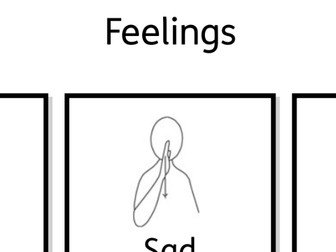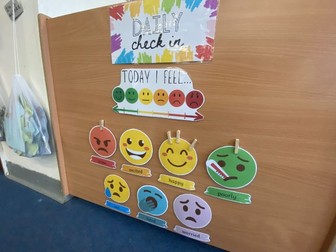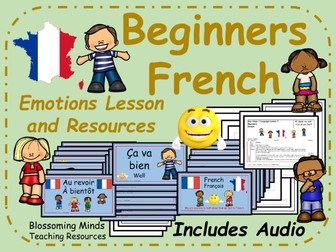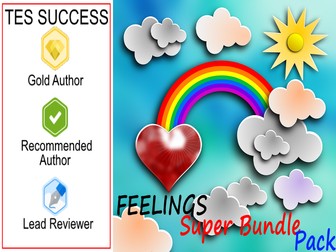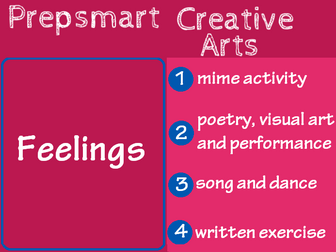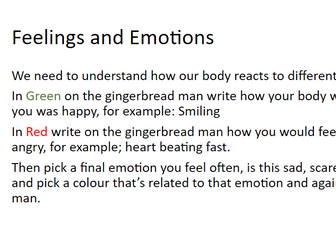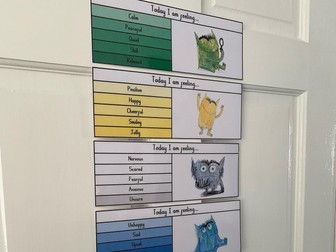Emotions + Feelings
<p>Emotions + Feelings KS2 Primary PSHE</p>
<p>1-2 hour, very detailed, fully resourced PSHE lesson suitable for KS2 which allows students to explore the different ways we express our feelings, how we can decipher different emotions and how we can express them using varied vocabulary. Created to fit the new DfE and PSHE Association statutory 2020 guidelines.</p>
<p>The lesson has been left editable and is filled with engaging, well differentiated and fun activities. It is designed to be ‘no prep’, so you can just pick it up and use it, although it is still adaptable should you wish to.</p>
<p><strong>Who are EC Resources?</strong><br />
EC Resources are the top TES PSHE providers and are a group of teachers who work together to create easy to use, high quality and editable lessons and units of work. We have created lessons for The bank of England, The Children’s Commissioner, The Bank of England, MACS Charity, Tes, LikeToBe Careers, the Criminal Cases Review Commission (UK Gov) and have also completed PSHE and Citizenship commissions for schools across the UK.</p>
<p>You can contact us at <a href="mailto:info@ecpublishing.co.uk" target="_blank" rel="nofollow">info@ecpublishing.co.uk</a></p>
<p>Teaching PSHE, RE or Citizenship GCSE next year? Why not join our <a href="https://www.facebook.com/groups/2069848026578974/" target="_blank" rel="nofollow">Citizenship and PSHE teachers Facebook group,</a> with 7000 other teachers, for guidance, advice and resource sharing.</p>
Natural Colour Monster Feelings
<p>This resource includes images for the colour monster story using real images from the story itself. The resource includes images of ‘happy, sad, calm, angry, scared, love and confused.’ This resource could be used to retell the story, to discuss emotions and feelings or in a calm corner or tinker box. Great for SEN children in particular. This resource just needs to be printed and laminated for longevity. They could also then be hole punched to hang up in your classroom or home too.</p>
Feelings Makaton Signs
<p>This is a handy resource with 12 Makaton signs about feelings on a A4 sheet.<br />
The signs include:</p>
<ul>
<li>Sad</li>
<li>Happy</li>
<li>Scared</li>
<li>Tired</li>
<li>Angry</li>
<li>Excited</li>
<li>Worried</li>
<li>Ill</li>
<li>Cold</li>
<li>Hot</li>
<li>Hungry</li>
<li>Thirsty</li>
</ul>
<p>Please check out my other Makaton resources to learn more Makaton signs, all on one side of A4 for easy reading.</p>
<p>Please leave me a review, if you like my resources. If there is a resource you would find particular helpful please let me know and I can make it.</p>
Daily Feelings Check In
<p>A pack of three resources for the classroom containing:</p>
<ul>
<li>Daily Check in title</li>
<li>Feelings scale</li>
<li>Large feelings faces with titles</li>
</ul>
The Color Monster Characters feeling puppets
<p>Large monsters and small stick puppets/cards/cut outs</p>
undefined
French lesson : Emotions and Feelings
<p>This is a plan and resources for a beginner’s French lesson to use with KS2. It would be perfect to use as a second French lesson, after children have learnt to say hello. The focus in this lesson is on how to ask <strong>‘how are you’ and reply.</strong></p>
<p>The plan gives details of a starter, how to teach the ‘feelings’ vocabulary, a speaking and listening activity, paired game, reading/writing activity and plenary. It is <strong>highly interactive</strong> and allows children to practise a range of language skills.</p>
<p>There is a PowerPoint which includes an <strong>audio version</strong> of each French word or phrase to make it easier for anyone to be able to teach the lesson. You can also play the PowerPoint without the audio.</p>
<p>All resources needed for the lesson are included in the price. They are in the zip file. These are:</p>
<ul>
<li>The 4 page PDF lesson plan</li>
<li>A 21 Slide animated PowerPoint presentation (This is not editable. Click the ‘Read Only’ button to open. Some of the images are only revealed when the PowerPoint is played as a slideshow with the animations.)</li>
<li>5 PDF sheets for the speaking activity</li>
<li>2 PDF sheets for the paired game</li>
<li>3 PDF sheets for the Reading/Writing activity (colour and black & white versions and an answer sheet)</li>
</ul>
<p>No further preparation needed.</p>
<p>This is lesson 2 of Unit 1 French designed by Blossoming Minds.</p>
<p>Unit 1 French - Greetings and introductions lesson bundle is available here:<br />
<a href="https://www.tes.com/teaching-resource/resource-11631397">https://www.tes.com/teaching-resource/resource-11631397</a></p>
<p>Unit 2 French - All About Me - Age and Appearance is available here:<br />
<a href="https://www.tes.com/teaching-resource/resource-11707339">https://www.tes.com/teaching-resource/resource-11707339</a></p>
KS2 Feelings Cards
<p>Vocabulary cards covering:<br />
Joy<br />
Sadness<br />
Anger<br />
Envy<br />
Embarrassment<br />
Fear<br />
Anxiety<br />
Disgust</p>
<p>1 version PDF with sign posts only under each tree<br />
A version is in Word so you can add your own characters like my example on instagram using the Inside Out Characters.</p>
<p>1 set ‘emotions’ and 1 set ‘feelings’ so you can use whichever you prefer.</p>
Describing Feelings
<p>Complete lesson pack on describing feelings and emotions for Entry 3 / B1 ESOL / ESL / EFL students.</p>
<p>Included are a PowerPoint to present new language, a Language Reference and Sentence Builder booklet, suggestions for receptive processing activities following Gianfranco Conti’s EPI Method and 7 pages of vocabulary, reading, speaking and writing activities, including a focus on -ed and -ing adjectives.</p>
<p>The specific lexical items featured and recycled throughout the lesson are:</p>
<p><em>anxious; annoyed; confused; devastated; disappointed; embarrassed; exhausted; frustrated; furious; proud; shocked; terrified;</em></p>
<p>but materials are presented as PDF and Word Doc, so alternative words could be used.</p>
Feelings / emotions activity for social skills
A resource I made for a mixed group of ks1 / ks2 children with autism / social communication needs. Aim is to develop greater understanding of feelings and to begin to develop awareness of other's feelings, also turn taking and attention and listening.<br />
<br />
Resource includes a feelings poster and 18 cards describing situations that have happened to an imaginary child - e.g. 'She has a wobbly tooth'.<br />
<br />
We discuss the various feelings an how children are feeling today. Cards are placed face down and children take turns to turn cards over. They consider how the person may be feeling.<br />
<br />
More able groups could be prompted / questioned to consider would everyone feel that way in that situation (some people can't stand having wobbly teeth, others get excited...) further developing theory of mind and understanding that people can feel differently about situations.
Feelings
Social Skills activity where students label the facial expressions with the correct feelings.
Feelings
<p>This is a pre-intermediate (CEFR B1, IELTS 5.0) EFL Speaking class about feelings. Students begin the lesson by reading four sentences and describing how they would feel in each situation. Students then look at six images, each of which shows a feeling (lonely, bored, stressed, shy, proud, confident). The pronunciation and form of each word is then drilled. Students then read a short text about a girl called Danielle and her first day at a new job. Students use the target language by confirming their understanding of the text. Two free discussion activities are then completed.</p>
Feelings
<p>This is an advanced (CEFR C1, IELTS 7.0) EFL Speaking class about feelings. Students begin the class by reading four situations and discussing how they would feel in each. Next, target language (petrified, livid, dejected, invigorated, indifferent, suspicious) is introduced using photographs of people. Students then match the new vocabulary to a more basic definition. Students then drill the pronunciation and form of the target language. Next, students discuss what makes them feel of each the new words with a partner. After that, students match the target language to a basic synonym e.g. livid - angry. A reading article about the Buy Nothing movement, emphasis on the feeling of indifference, is introduced using pictures. Students then read the article and discuss the ideas in the text. Finally, students end the class by discussing the last time they felt each of the newly-learned emotions.</p>
Feelings
<p>This is a beginner (CEFR A2, IELTS 4.0) EFL speaking class about feelings. Students will learn vocabulary related to feelings, after which they learn the pronunciation of each word. Then there is a concept check exercise to confirm the students’ understanding. Finally, students discuss in free activities.</p>
Bundle
Feelings
<p>Are you needing to teach students about their different feelings and how they should react to each of these feelings? This bundle has lots of different great resources to help guide your students in how to feel better. Help your students become happier and be able to express their feelings more openly. Try it today!</p>
Feelings
<p>A FOUR item resource package focusing on developing awareness of feelings and communicating feelings through movement, art, performance and writing. Uses a variety of texts as starting points.</p>
<ol>
<li>A mime activity</li>
<li>Poetry, visual art and performance</li>
<li>Song and dance</li>
<li>Written exercise<br />
Includes worksheets and full memos/rubrics</li>
</ol>
Feelings
<p>2 lessons one looking at feelings and the other understanding feelings.<br />
Lesson 1: Gets the student to think of a feeling they struggle with, writing when they last felt it etc, then looks at comparing 3 different emotions.<br />
Lesson 2: Looks at ways of coping, so different coping mechanisms for students to try.</p>
Colour Monster Feeling Prompts
<p>These seven colour monster inspired feeling cards are a great way to assess how the children are feeling throughout the day. It is another great way of getting children to use synonyms for words such as ‘happy’ or ‘sad’. There are seven characters available - can either peg children’s names on or put them in a jar etc.</p>
Using Stress and Intonation to express feelings
You can use stress and intonation to express how you feel about something when you speak. Listen to these examples of people speaking with and without emotion and try to match the native speakers by speaking aloud.<br />
<br />
Now you can practise your stress and intonation. Write a sentence about the area where you live. Say your sentence out loud, with and without emotion.
Inside Out Feeling cards
<p>I will use this in my calm box so that children can understand how they are feeling.</p>

